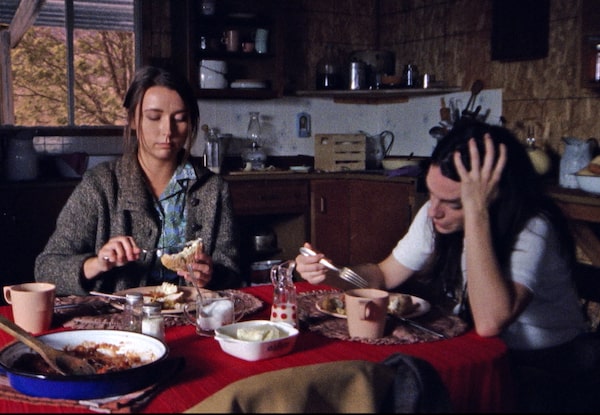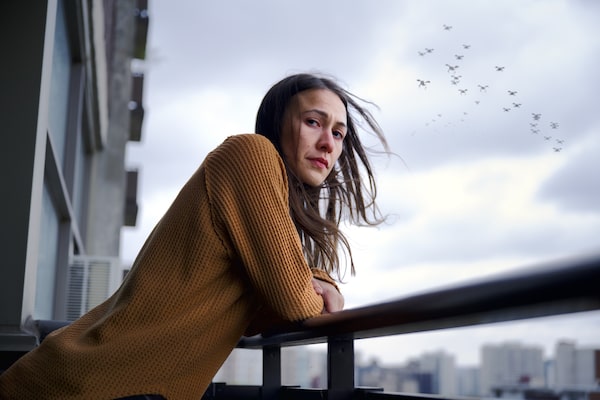
Ste. Anne explores the idea of place through non-linear images and stories.Courtesy of Rhayne Vermette
Plan your screen time with the weekly What to Watch newsletter, with film, TV and streaming reviews and more. Sign up today.
“I was at the back of the line. I met with all the prejudice that existed.” Alanis Obomsawin, the visionary Abenaki filmmaker, musician and activist, uses that delicate understatement to describe her experience as a documentary director in Canada in the early 1970s. One bureaucrat told her she was not allowed to interview white people for her films. “I didn’t strangle her,” Obomsawin, 89, says with a smile. “But she had the wrong Indian.”
Fifty years have passed since Obomsawin’s first film, Christmas at Moose Factory (1971). Since then, she’s made more than 50 others, about community, dignity and resisting injustice. Nineteen of her films – some shorts, some full-length features – will screen at this year’s Toronto International Film Festival, divided into six programs under the heading “Celebrating Alanis.” Several Indigenous filmmakers will be at TIFF alongside her, including Danis Goulet, whose Night Raiders sends a Cree mother and daughter on the run in a dystopia where children are property of the state (all echoes of Canadian residential schools intentional); Bretten Hannam, whose Wildhood takes its two-spirit Mi’kmaw hero on a journey back to their mother; and Rhayne Vermette, whose Ste. Anne explores the idea of place through non-linear images and stories.
In late August, The Globe and Mail’s Johanna Schneller convened all four filmmakers for a Zoom interview to see if they share Obomsawin’s optimism, and to ask what still needs to change. (It’s not what you may think.) Here are condensed and edited excerpts from that conversation.
Canadian Indigenous filmmaker Danis Goulet's film Night Raiders will be screened at the Toronto International Film Festival.Fred Lum/the Globe and Mail
Goulet: Things definitely have changed for the better – because people fought for it. But the barriers are still real. When I came to Toronto from Saskatchewan in the early 2000s, I got involved with the imagineNATIVE Film and Media Arts Festival. Producers were looking for ‘”Indigenous content,” but we were saying “It’s not Indigenous content unless Indigenous creators are involved at every level.” That conversation wasn’t on the radar then. I would make that case and get met with silence. But there were enough of us pushing for that vision that we created the Indigenous Screen Office, the targeted funding stream at Telefilm.
Schneller: Yet you still got tone-deaf notes on Night Raiders’s script. In 2013.
Goulet: A major broadcaster told me it was a propulsive story, “But priests are no longer beating up Indigenous kids in residential schools, so we don’t think the allegory works.” That happened in the very month that the Truth and Reconciliation Commission released their findings.
Hannam: When I started the script for Wildhood in 2010, people asked me, “Do they have to be Native? Do they have to be gay? Can they be women, because lesbians are a hot market item?” I said, “Why can’t it be what it is?” I’ve changed things in the past, and it was bad. I’ve learned, don’t let your space be intruded on. So with Wildhood I just sat on it. For a long time.
Schneller: You faced a different challenge when you made it.
Hannam: The way the industry makes films is hierarchical. There’s a chain of title. That inherently is a challenge for me, because I like to collaborate, to speak in a circle. I’m slow. I take time to think. I’m better at listening than speaking. So on a set it can appear that I’m spaced out. But I’m watching, I’m figuring things out. I don’t see it as, “I’m leading troops into battle.” If I don’t know something, I don’t hesitate to say. And when we’re dealing with animals, or land, it’s, “Everyone move back, go way over there, we need to create space, we need to have respect.” I like to share! Films sets don’t lend themselves to that. It’s more like, dictate and yell. So I need support from creative partners all around me, who protect that space for me.
Vermette: We have a significant film culture here in Winnipeg, which I initially accepted. But it’s not diverse. I tried to study film at the University of Manitoba. In my first class, I was told my film was not a film because it didn’t have dialogue. The next class I slept through, because it was all “legends: – non-diverse men. I participated in an Indigenous-based incubator, but there were no Indigenous people at the helm, just white people. They would say, :Beading! Jigging!: These identity tropes that weren’t me. My space as a Métis woman is complex, and that’s what I love about it. So Ste. Anne came out of wondering how that could be expressed in film.
We had a super-small budget, funded by arts councils. There was no hierarchy; everyone got paid the same. The constraints of our abilities became our innovations. There were five cinematographers, which reflected the matriarchal umbrella of our set. The camera was a communal space. The actors are my friends and family. Our mantra was, “Keep It Chill.” Anyone can show up on set and put in their 12 hours, but everyone who touched my film put their love into it. How you quantify that, I don’t know.
Obomsawin: I find it so exciting to hear young people saying, “This is my story, this is how I want to tell it.” So many times, people said to me, “Change what this person is saying,” or “End your film differently.” That’s over. Don’t listen to people who want you to change your story. That’s like someone saying, “No, your life wasn’t like that, it was like this.”

Indigenous filmmaker Alanis Obamwasin will receive Jeff Skoll Award in Impact Media at TIFF 2021.Scott Stevens
When I was a young girl, my community didn’t have electricity or running water, and we had an earth road. I don’t say dirt road, that’s an insult to my Mother – the Earth is not dirty, it gives you everything. We had oil lamps. At night, we were in the kitchen, the adults were fishing and hunting guides, and a lot of their stories were experiences in the bush. If you had four or five children listening, you have four or five sets of images in their minds. That’s four or five films right there.
For me the root of making films is always listening. The word is sacred. So I make many visits to people who I think I want to make a film about. I never come with the camera first. I listen. That develops a trust, and places you in such a beautiful place in the heart of a person, who then is not afraid.
One time I was interviewing a Métis woman who was 113 years old. I asked her to tell me about a day in her life when she was happy. She started to cry. She told me she was never happy: Her father died when she was young; her stepfather abused her sexually. This has gone through so many generations of our people. For a very long time there was dead silence. My people are so beautiful, but they don’t know it. So to listen to them is sacred to me.
Goulet: It’s beautiful listening to Alanis talk about her process, which is all about ethics and responsibility. The misrepresentation that our people endured over 100 years of cinema propagated harmful stereotypes, with real-life consequences. So we take our responsibility as storytellers really seriously. We need to hold people’s stories with that much love and respect and dignity. We need to approach filmmaking from a values perspective. It’s incredibly challenging, because the system as it’s set up often clashes with our values as Indigenous filmmakers. At every step we have to ask ourselves, “This business advice that I’m getting from a distributor or executive – is it in line with my values?” That’s a hard space to continually push back against. We need each other in order to do it. But we also need the system to change.

Elle-Maija Tailfeathers stars as a Cree mother trying to reunite with her daughter in Danis Goulet's thriller Night Raiders.TIFF via The Canadian Press
On Night Raiders, I was so lucky to have my associate producer, Eva Thomas, hold that cultural space for me. She did community outreach, worked with elders. My actors were bringing their lived experience to their roles. We had to keep them safe. I had to make the case that those endeavours were as important as any other endeavour on the film. Even more important. The Indigenous Screen Office funded a mentorship program so we could have more Indigenous people on set, and I needed that. When I go on a set, I don’t want to be the only one. Throughout the industry, we need Indigenous presence everywhere: in every job in the crew, at funding agencies, distributors, production companies.
Vermette: The bureaucratic industry language needs to change, because that is a barrier in and of itself. My breakthrough came when I found the Indigenous Filmmakers Collective, a monthly gathering where everyone was accepted. It was the first time I had people I could collaborate with, and feel comfortable sharing my ideas. We need more organizations like that. If you don’t know who your peers are it’s hard to work.
Goulet: That is the most important thing. Find like-minded people who want to support what you do. The power of creative clusters, what you’re able to do with your peers, is more powerful than anything you can do alone.
Hannam: Make short films. There’s more freedom to experiment, to find your voice. It’s important to mess up and to fail. The world is complex and contradictory. Our stories don’t fit neatly into labels and formulas, the way a colonial perspective wants them to. Male/female, light/dark, hate/love – that binary is imposed, artificial. Your way of seeing is your own, and it’s sacred.
Schneller: Danis mentioned the harmful stereotypes perpetuated by cinema. Your films are changing that. They’re reshaping what we think of as Canada’s history.
Hannam: I’ve never thought of it in that large of a scale. I focus on my community and territory. I try to make things to help heal and for people to enjoy, and to make space so the people who come after us can tell stories easier. There are so many stories. They’re alive and they’re there, waiting. There are as many stories as there are trees.
Goulet: I wanted to tell the story of Night Raiders to explore the impact of colonial policies on every aspect of Indigenous life. I also want to be part of our communities seeing themselves on screen – the power of that can’t be overestimated, especially when we have historically been excluded from the privilege of telling stories through cinema. To watch people, both Indigenous and not, go into a theatre and come out with their minds totally blown or transformed – I want to contribute to that.
Schneller: So we believe this change is lasting? Are you skeptical, hopeful, both?
Obomsawin: For me it’s much more profound than hope. It’s real. Where we’re going, we’ve never been there before. The stories we are telling, the respect our people receive now, it’s going to go even higher. Wait another 10 years, it’s going to be incredible.

Indigenous filmmaker Danis Goulet's Night Raiders sends a Cree mother and daughter on the run in a dystopia where children are property of the state.SAMUEL ENGELKING
Sign up for The Globe’s arts and lifestyle newsletters for more news, columns and advice in your inbox.
 Johanna Schneller
Johanna Schneller